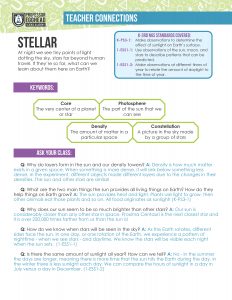Stars are large balls of hydrogen and helium gas. At the center of a star, called the core, gas gets very hot and gets pushed outwards to the surface of the star. We see this gas as the photosphere layer of the sun. A group of stars together in the night sky that make a picture is called a constellation.
Keywords
- Density
- Core
- Photosphere
- Constellation
materials list
- Cup (10z or larger)
- Vegetable oil (4 oz)
- Pebble, rock, or marble
- Toothpick or small piece of wood
- Alka Seltzer or generic tablet
- Small Cup (5 oz)
- Pushpin (Parent Supervision Required)
- Flashlight
- Optional: Printed Constellation Sheet
background
Our sun is a star and is the closest one to us by trillions of miles. The center of our sun, called the CORE, can reach temperatures of 27 million degrees Fahrenheit. With that much heat, hydrogen is pressed together with intense pressure to form helium. When atoms are pressed together and form a new element, it’s called fusion. The heat and the light that we receive from the sun is actually a byproduct of fusion, and this is how stars illuminate the sky.
While stars are mostly hydrogen and helium, there are distinct layers as you make your way closer to the center of the star. These layers are formed by changes in DENSITY or, the amount of matter inside an object. The outermost layer, called the CHROMOSPHERE, is the least dense. This layer causes shades of orange and yellow and the name comes from chromo meaning color, and sphere. The next layer is what we see when we look at the sun. It’s called the PHOTOSPHERE. It produces the light that we see and the word comes from photo- meaning light, and sphere. Deeper into the sun, we would reach the convective zone, followed by the radiative zone, and finally the core. Each layer is more dense than the layer above it.
The core is where fusion occurs meaning it’s where the heat of a star is generated. Hot helium and hydrogen become less dense and move outwards from the core. As the heat travels outward, it moves through the radiative zone until it reaches the convective zone. Just like hot magma in the earth moving towards the surface, in the convective zone, the hydrogen and helium gas are heated, and towards the surface of the sun as a result. When they reach the surface, the gas cools and falls back down into the sun. This process of heating, rising, cooling, and falling is called convection.
In ancient times, people grouped stars together into patterns called constellations. A CONSTELLATION is a group of stars that make a picture. A good example is the constellation of Orion the Hunter. Orion the Hunter appears to be a man standing straight up, holding a bow in front of him. The three stars that form his belt are some of the most recognizable in the night sky. Although these pictures are arbitrary and do vary from culture to culture, they can be useful for purposes other than storytelling and folklore. If you know where the earth is in its rotation around the sun, you can use constellations to know what time it is and where you are on the earth. For example, if the month was February, and Orion was located directly south, you could deduce the time as approximately 9:00pm. Or, if you knew that the time was 9:00 pm and you saw Orion, you would know that direction was south.
keywords
DENSITY: How much matter is inside an object
CORE: The center of the sun
PHOTOSPHERE: The part of the sun that makes bright light
CONSTELLATION: A group of stars that make a picture
science standards
K-PS3-1: Make observations to determine the effect of sunlight on Earth’s surface.
1-ESS1-1: Use observations of the sun, moon, and stars to describe patterns that can be predicted.
1-ESS1-2: Make observations at different times of year to relate the amount of daylight to the time of year.

